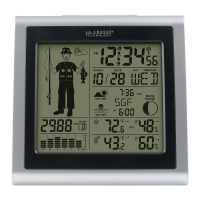
Do you have a question about the La Crosse 308-1451 and is the answer not in the manual?
| Display Type | LCD |
|---|---|
| Indoor Temperature Range | 32°F to 122°F (0°C to 50°C) |
| Outdoor Temperature Range | -40°F to 140°F (-40°C to 60°C) |
| Humidity Range | 10% to 99% RH |
| Wireless Range | 300 feet (91 meters) |
| Humidity Resolution | 1% RH |
| Power (Display) | 2 AA batteries |
| Power (Sensor) | 2 AA batteries |
| Weight (Sensor) | 3.2 ounces |
| Temperature Resolution | 0.1°F or 0.1°C |
Lists device capabilities like Atomic Clock, Calendar, Time, Temp/Humidity, Forecast, Sunrise/Sunset, and Clothing Index.
Instructions for inserting 3 AA batteries into the main weather station unit, observing polarity.
Instructions for inserting 2 AA batteries into the TX142TH wireless transmitter, observing polarity.
Instructions for inserting 2 AA batteries into the TX14TH wireless transmitter, observing polarity.
Explains the function of buttons located on the back of the weather station unit.
Details how to set time, calendar, time format, units, and WWVB reception via the program menu.
Guides on how to enable or disable the automatic radio-controlled time reception.
Instructions for selecting the correct time zone from seven available options.
How to set the Daylight Saving Time indicator to ON or OFF for accurate time.
How to select between a 12-hour (AM/PM) and 24-hour time display.
How to choose the temperature display units between Fahrenheit (°F) and Celsius (°C).
Step-by-step guide to manually set the hour, minute, and second for the clock.
Instructions for setting the year, month, and date for the calendar display.
How to select a city for accurate sunrise/sunset and moon phase time calculations.
Explanation of how tide levels (high, low, mid) are displayed based on lunar phases.
Describes the 6-section moon phase indicator and how to interpret its phases.
How indoor humidity levels (above 64%, 43-64%, below 42%) determine the comfort statement.
Lists the 9 different alarms available for the forecast station and transmitters.
Guides on setting and activating the two individual time alarms on the forecast station.
Detailed steps for setting and activating the first individual time alarm.
Detailed steps for setting and activating the second individual time alarm.
How to activate the snooze feature for 10 minutes when an alarm sounds.
How to activate and deactivate the frost alarm that sounds below 34°F (1.1°C).
General instructions for setting high and low temperature alarms for outdoor channels.
Instructions for setting temperature alarms for specific outdoor transmitter channels (1, 2, & 3).
Explains indicators for rising, stable, or falling temperature trends over three hours.
Information about absolute pressure readings and why they may differ from local stations.
How to switch pressure display between Inches of Mercury (InHg) and Hectopascals (hPa).
How to view the past 12 hours of numeric pressure history data.
Explains the bar chart showing air pressure trends over the last 12 hours.
Interprets the icons that forecast weather conditions for the next 12-24 hours.
Explains indicators showing air pressure increase, decrease, or no change.
Shows fisherman clothing combinations based on current outdoor temperature trends.
How to view and reset minimum/maximum indoor and outdoor temperature data.
How to select, view, and auto-scroll through multiple outdoor transmitter channels.
Detailed steps for connecting up to three remote outdoor transmitters to the forecast station.
Explanation of the NIST WWVB radio station and its time signal transmission.
How to interpret the WWVB signal strength icon for time reception success.
Instructions on how to manually initiate a search for the WWVB time signal.
Advice on battery handling, cleaning, and general care for the forecast station.
How to identify and respond to low battery warnings for the station and transmitter.
Recommendations for optimal placement of the outdoor transmitter for accurate readings.
Guidance on selecting a location for the main unit for best reception and performance.
Technical details including temperature/humidity ranges, intervals, and power requirements.
Technical details for the outdoor transmitter including range, intervals, and dimensions.
Information on battery types needed for the station and transmitter, and expected battery life.
Details on the 1-year limited warranty, how to view details, and contact information.
Information regarding compliance with FCC rules for digital devices and potential interference.
Specifies the two conditions under which the device operation is permitted.

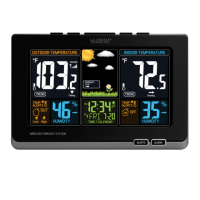
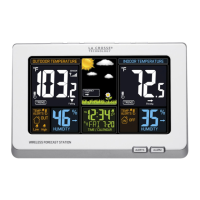
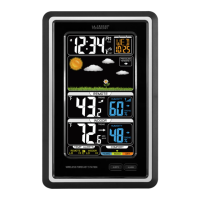
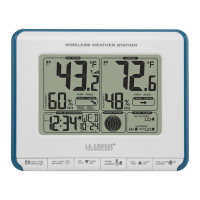

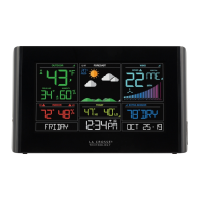
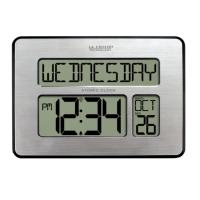
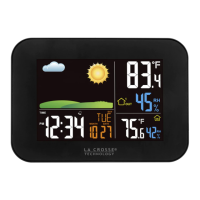
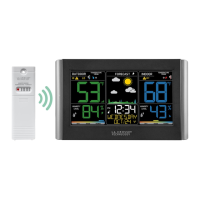

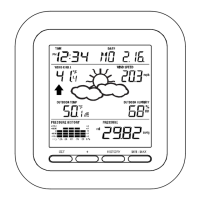
